Potential Issues of Flushing Cat Poop Down Your Toilet - Safeguard Your Pipes
Potential Issues of Flushing Cat Poop Down Your Toilet - Safeguard Your Pipes
Blog Article
Do you find yourself trying to find resources around How to Dispose of Cat Poop and Litter Without Plastic Bags?

Intro
As pet cat proprietors, it's vital to be mindful of how we get rid of our feline good friends' waste. While it may seem convenient to flush pet cat poop down the bathroom, this technique can have harmful effects for both the atmosphere and human health.
Alternatives to Flushing
Fortunately, there are safer and much more responsible methods to throw away feline poop. Consider the complying with choices:
1. Scoop and Dispose in Trash
The most usual approach of throwing away cat poop is to scoop it into an eco-friendly bag and toss it in the garbage. Be sure to use a committed litter scoop and get rid of the waste without delay.
2. Use Biodegradable Litter
Select biodegradable cat litter made from materials such as corn or wheat. These clutters are eco-friendly and can be securely taken care of in the garbage.
3. Hide in the Yard
If you have a lawn, think about burying cat waste in a marked location away from vegetable gardens and water resources. Make sure to dig deep adequate to prevent contamination of groundwater.
4. Mount a Pet Waste Disposal System
Purchase a pet garbage disposal system particularly developed for pet cat waste. These systems use enzymes to break down the waste, lowering smell and environmental influence.
Health and wellness Risks
In addition to ecological concerns, purging feline waste can likewise present health dangers to human beings. Feline feces might consist of Toxoplasma gondii, a bloodsucker that can trigger toxoplasmosis-- a potentially serious ailment, especially for expectant ladies and individuals with weakened immune systems.
Ecological Impact
Purging pet cat poop presents dangerous microorganisms and bloodsuckers right into the water supply, posing a considerable risk to marine ecosystems. These pollutants can adversely influence marine life and concession water top quality.
Final thought
Liable family pet ownership extends past supplying food and shelter-- it likewise involves appropriate waste management. By refraining from purging cat poop down the commode and going with alternate disposal methods, we can decrease our environmental impact and safeguard human wellness.
Why Can’t I Flush Cat Poop?
It Spreads a Parasite
Cats are frequently infected with a parasite called toxoplasma gondii. The parasite causes an infection called toxoplasmosis. It is usually harmless to cats. The parasite only uses cat poop as a host for its eggs. Otherwise, the cat’s immune system usually keeps the infection at low enough levels to maintain its own health. But it does not stop the develop of eggs. These eggs are tiny and surprisingly tough. They may survive for a year before they begin to grow. But that’s the problem.
Our wastewater system is not designed to deal with toxoplasmosis eggs. Instead, most eggs will flush from your toilet into sewers and wastewater management plants. After the sewage is treated for many other harmful things in it, it is typically released into local rivers, lakes, or oceans. Here, the toxoplasmosis eggs can find new hosts, including starfish, crabs, otters, and many other wildlife. For many, this is a significant risk to their health. Toxoplasmosis can also end up infecting water sources that are important for agriculture, which means our deer, pigs, and sheep can get infected too.
Is There Risk to Humans?
There can be a risk to human life from flushing cat poop down the toilet. If you do so, the parasites from your cat’s poop can end up in shellfish, game animals, or livestock. If this meat is then served raw or undercooked, the people who eat it can get sick.
In fact, according to the CDC, 40 million people in the United States are infected with toxoplasma gondii. They get it from exposure to infected seafood, or from some kind of cat poop contamination, like drinking from a stream that is contaminated or touching anything that has come into contact with cat poop. That includes just cleaning a cat litter box.
Most people who get infected with these parasites will not develop any symptoms. However, for pregnant women or for those with compromised immune systems, the parasite can cause severe health problems.
How to Handle Cat Poop
The best way to handle cat poop is actually to clean the box more often. The eggs that the parasite sheds will not become active until one to five days after the cat poops. That means that if you clean daily, you’re much less likely to come into direct contact with infectious eggs.
That said, always dispose of cat poop in the garbage and not down the toilet. Wash your hands before and after you clean the litter box, and bring the bag of poop right outside to your garbage bins.
https://trenchlesssolutionsusa.com/why-cant-i-flush-cat-poop/

I was made aware of that report on How to Dispose of Cat Poop and Litter Without Plastic Bags from someone on another web address. Sharing is nice. Helping others is fun. Thank-you for taking the time to read it.
Call Today Report this page